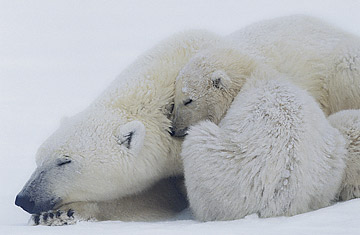
A scene from the Disney film Earth
The new Disney movie arriving in multiplexes on April 22 features lots of animals — none of them cartoons. The ambitious new nature film called Earth chronicles a year in the life of the planet, opening in the dead of winter at the Arctic, with a mother polar bear peeking her snout out of the snow, and ending at the opposite pole, in the brief Antarctic summer amid a dance of humpback whales.
Produced by Disney's new film unit Disneynature, Earth marks the company's grand re-entry to the big-screen nature doc arena — which, as today's children are too young to recall, Disney re-invented in the 1950s with its True Life Adventures wildlife series, including six feature films and seven shorts. Before Disney, animals were often depicted on film as targets, either for collectors or, more often, for hunters. True Life Adventures went the opposite direction, anthropomorphizing wildlife and elevating their life experience to dramatic effect. (Would the creator of Mickey Mouse be expected to do anything else?) (See the 100 best movies of all time.)
The truthiness of the films aside, True Life Adventures can be credited for being the first to present nature in a quietly empathetic way — wildlife weren't a threat, but an integral part of our lives and worthy of protection — that would later resonate with the modern environmental movement.
Prompted by the public's increasing interest in all things environmental, as well as the success of 2005's Academy Award-winning March of the Penguins, Disneynature was created in 2008 to produce one to two nature films a year. The idea was not to pump out dry nature docs, but to re-invent the product once again and introduce it back into the theater. "We're not just bringing TV documentaries to the big screen," says Jean Francois Camilleri, the general manager of Disneynature. "We want to go with the movie screen and tell a story as big as we can."
But in the case of Disneynature's first big-screen venture, it is largely that: a transplant and blow-up of a TV documentary to the big screen. In Earth, filmmakers Mark Linfield and Alastair Fothergill capture a caravan of elephants crossing the brutal Kalahari Desert, along with a pride of hungry lions, and the rainbow of natural marvels contained in the rainforests of Papua New Guinea. The narrative theme is the sun, the source of life and the bringer of seasons, from one pole to the other. The film is narrated by James Earl Jones.
But if any of the footage seems familiar, it's probably because you've already seen it for free on television, in the BBC miniseries Planet Earth (repackaged also by the Discovery Channel in the U.S.). Earth was shot alongside Planet Earth, using many of the same crew, in part to cut costs. At least half of what is contained in the Disney film has already been released on the BBC, Discovery Channel and DVDs.
But that doesn't dissuade the makers of Earth. "This is cinema," says Linfield. "These are the images we knew would work well on the big screen."
What is new here is remarkable. In one sequence shot entirely in night vision, a ghostly green pride of lions stakes out a watering hole and hunts and kills a young male elephant, in the midst of a violent electrical storm. Another scene shows a flock of cranes struggling against the wind to cross the Himalaya Mountains. (See the top 10 movie performances of 2008.)
Despite the intense nature of some of the footage, Disneynature has cleaned up the material for young children — no actual killing is shown on film — and Earth is rated G. For a nature film, Earth also takes a notably G-rated stance on the subject of the environment. Climate change is mentioned a few times in passing — and we see a male polar bear in northern Norway struggling with melting sea ice — but there is no real message or explanation of it here. Instead of doom, the overall mood is joy, the renewal that comes with rain and sun and summer. Never mind that there's less rain and hotter summers — this film has a Disney-worthy happy ending, even if the Earth may not.
"The most powerful thing you can do in conservation is to see what's at stake," says Linfield. "We wanted to show what's left."
Linfield and Fothergill are helming Disneynature's next project, Big Cats, which follows three feline mothers — a lioness, a leopard and a cheetah — on the African plains. After that, the company plans to release Naked Beauty, which is about flowers and pollination.
Earth will be opening on more than 1,800 screens around the country today, and Disney has high hopes for it. "This is probably the biggest release of a nature film in history," says Camilleri.
